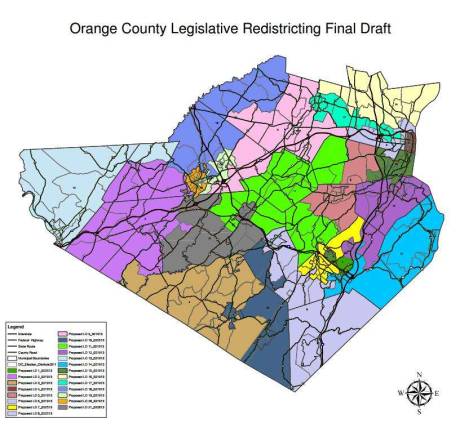Latinos' rise opens redistricting to scrutiny

GOSHEN — A growing Hispanic population has slowed down the redrawing of Orange County's legislative districts, opening the historically clandestine process to wider scrutiny by lawmakers.
The delay in approving new outlines for legislators' home turf began with concerns over a population of some 13,000 Latinos of voting age in the City of Newburgh and another burgeoning Hispanic population in Middletown.
But other concerns also linger over the redrafting of densely populated southeastern districts covering the towns of Monroe, Woodbury, and Tuxedo.
Democratic Legislator Myrna Kemnitz said that the new shape of her home turf in District 7 will hamper her ability to find a happy middle ground with her constituents.
“The way it is now cut, I represent three distinct municipalities that are at war against each other,” she said.
If the map is approved, Kemnitz will represent parts of the Town and Village of Monroe, the Village Kiryas Joel and the combined Town and Village of Woodbury.
Monroe is currently suing Woodbury over the annexation of land by Kiryas Joel, and Woodbury is suing Kiryas Joel over pipeline and sewage development, Kemnitz said.
Under the proposal, a handful of voting districts that Kemnitz won previously will go to District 8 represented by Republican Legislator Dan Castricone, who accepted the changes proposed to his district.
“The vast majority of my district … will attend Monroe-Woodbury High School,” Castricone said. “That makes for a nice commonality of interest in the district and will make it easier to represent those people.”
The proposed maps were the work of the Legislative Chairman, Michael Pillmeier and Legislator Katie Bonelli, both Republicans.
At a meeting of the Rules Committee on Tuesday, many legislators reported they hadn't seen the revisions to their districts until Bonelli and Pillmeier decided to release them.
Democratic Minority Leader Jeff Berkman voiced his years' long opposition to the veiling of the redistricting process.
“It should have been much more transparent and bipartisan at the earlier stages,” Berkman said.
At a hearing last week Gerald Benjamin and Joshua Simons of the Center for Research, Regional Education and Outreach at SUNY New Paltz raised concerns about the populations of Hispanics living in the City of Newburgh.
Citing constitutional rules laid out in the Voting Rights Act, Benjamin and Simons urged Orange's map makers to redraft areas of the city to create the first district in the county where Latinos could comprise a majority of voters.
“The question is: Is it possible to draw a majority minority district? And, in this case, there is,” said Simons, who was able to draw a district with a concentration of Hispanics as high as 57 percent.
Districts may also need to be redrawn to accommodate a plurality of Latinos in Middletown, where their populations are similarly rising, Simons said.
The lack of attention to the Latino populations in Middletown and Newburgh may be a symptom of a bias in Orange County's method of redistricting, Simons said.
Rather than wiping the slate clean when new census data is collected every ten years, Orange County has based the creation of new districts on older districts already in place, county officials said.
In order to maintain the current districts, many of Orange County's 10,034 census blocks had to be split, said Megan Tennermann, the professional planner drafting the district maps.
Simons said this priority can undermine the influence that new census data should have in reforming political boundaries.
“By reapportioning based upon old districts, you're really putting the cart before the horse,” he said.
Simons said the county follows a trend across the state, where population growth has happened largely in cities, suburbs and other areas of high density.
Those areas also tend to be more diverse and tend to hold more registered Democrats than areas where populations are more dispersed.
Berkman said the consideration of the new maps before a public audience and again in committee proved the maps can be strengthened through more participation.
However, the late arrival of the maps has left little time for the legislators to act on their concerns ahead of elections in November.
“If these changes are not substantial then I'll vote against it,” Berkman said of the revisions affecting Hispanic communities.
Republican Patrick Berardinelli, who represents the portions of Newburgh that may change to accommodate the Latino vote, said that he opposed such changes to his proposed district.
“I think they are just pushing the issue when they say that the proportion of Hispanic, black or other is unrepresented,” he said. “I think that is totally false.”
Editor's note: The original text of this story has been altered to correct errors in reporting.